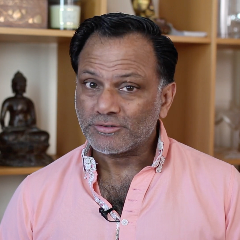You are not currently logged in. Please create an account or log in to view the full course.
Understanding Faces
- About
- Transcript
- Cite
Facial Processing and Recognition
In this course, Dr Ashok Jansari (Goldsmiths, University of London) explores the process of face recognition. In the first lecture, we think about what makes a face special as a visual stimulus. In the second lecture, we think about what information a face conveys, including identity and emotions. In the third lecture, we think about why human faces are special and explore some facial interpretations, such as a face inversion effect. Next, we think about prosopagnosia, aphantasia and super-recognition abilities. In the fifth and final lecture, we think about some current research on facial recognition, including its implementation in law enforcement and surveillance.
Understanding Faces
In this lecture, we think about what makes a face special as a visual stimulus, focusing in particular on: (i) the face acting as a key form of identity in humans; (ii) the function of a face to communicate feelings to others; (iii) Johnson and colleagues’ study, which assessed the facial recognition abilities of newborn babies; (iv) research evidence which indicates towards there being a specialised brain region which is dedicated to recognising faces.
Hello.
00:00:06I'm Dr Al Sharpton. Sorry.
00:00:07And I'm a cognitive neuropsychologist at Goldsmiths University of London.
00:00:09In this course, I'm going to tell you about face recognition.
00:00:14I'm going to go through different aspects of face recognition.
00:00:19So what's in a face? Why are we interested in studying face recognition?
00:00:22Our faces special. Are they treated differently by the brain to other
00:00:28types of visual information?
00:00:33I'll also tell you about some of my own work,
00:00:35and then finally, I will finish off.
00:00:38We're telling you about the type of work that researchers are currently doing
00:00:41in the face recognition field.
00:00:45In this first lecture,
00:00:49I'm going to talk to you generally about What is it about faces that so intriguing
00:00:50now? Importantly,
00:00:56we use faces for recognition
00:00:58who someone is, whether they're friend or foe.
00:01:01All of this information comes from seeing a human face.
00:01:05Now I'll give you an alternative to think about
00:01:11to explain why face recognition is so important.
00:01:15We know that dogs have this incredible sense of smell.
00:01:19They're probably not going around looking at human faces or other dogs,
00:01:23faces or cuts faces and trying to recognise them by their face.
00:01:28They're doing it by smell because the smell is such an important cue
00:01:34for them that they can process
00:01:40information and probably remember recognise etcetera.
00:01:42We don't go around sniffing people and smelling them to try to recognise them.
00:01:47What are we doing?
00:01:51Well, it's all coming from this.
00:01:52There's something compelling about the human face.
00:01:55It's a form of communication.
00:01:59So if I'm looking sad, you'll get some information from that.
00:02:00The fact that my main form of communication, which is speaking,
00:02:05is coming from my mouth, which is on my face.
00:02:10We protests
00:02:13and convey a lot of information through our eyes so
00:02:15I can look startled or I can look worried.
00:02:19And all of this information is coming
00:02:22from the face.
00:02:24So there are good reasons for assuming that there is something quite
00:02:26important about what's going in this part of the human body.
00:02:31Now, when we look at babies,
00:02:36we know that there's something happening even with babies,
00:02:38with with respect to face recognition
00:02:42when were really young, when we're just out of the womb, etcetera.
00:02:47We don't have any understanding of the human face.
00:02:52But studies have been done where cartoon images are
00:02:55shown to babies which show configuration of two dots,
00:02:59something in the middle here and something down here that are in
00:03:06this configuration of eyes, nose and mouth.
00:03:11And what we find is that at some point,
00:03:15even very young babies are able to tell the
00:03:19difference between that configuration and the same information,
00:03:22but scrambled up.
00:03:26So when I hear when I hear a mouth here and knows here,
00:03:27so it's the same visual information scrambled up and a baby will be able to tell
00:03:31that apart from an image which has got the two eyes, the nose and the mouth.
00:03:37So what that suggests
00:03:42is that at some level
00:03:43there's a part of the brain
00:03:46that has become specialist for detecting this.
00:03:49When we're born, that part is asleep.
00:03:52But as we get more and more information from seeing our parents, other carers,
00:03:55our siblings that are handling us when we're babies,
00:04:02we start noticing that there's this pattern,
00:04:05these two things above this above this,
00:04:07and it seems to be activating a certain part of the brain,
00:04:11which then we use for recognising faces.
00:04:15So, generally speaking,
00:04:19there's quite a bit of information that's coming from a human face,
00:04:21and we know by studying babies that babies seem to
00:04:27latch onto certain information on our face for recognising us,
00:04:31and therefore there must be something special about this.
00:04:37So, generally speaking, in this first lecture,
00:04:42I've been introducing you to the fact that there's a
00:04:45reason for trying to understand what's happening with face recognition.
00:04:48In the next lecture,
00:04:55I'm going to talk to you about the different
00:04:57types of information that comes from a human face
00:04:58and how we can start understanding that by studying people
00:05:01with brain damage that affect certain aspects of face recognition.
00:05:05
Cite this Lecture
APA style
Jansari, A. (2022, June 09). Facial Processing and Recognition - Understanding Faces [Video]. MASSOLIT. https://massolit.io/courses/facial-processing-and-recognition
MLA style
Jansari, A. "Facial Processing and Recognition – Understanding Faces." MASSOLIT, uploaded by MASSOLIT, 09 Jun 2022, https://massolit.io/courses/facial-processing-and-recognition

